Virginia Native Plant Site Registry
The Virginia Native Plant Site Registry Program is a voluntary program designed by the VNPS to protect the plant treasures residing in natural communities throughout Virginia. Landowners and stewards who agree to register their properties as a Virginia Native Plant Registry Site take an important step towards preserving the natural features of the land. The program was launched at the September, 1989 Annual Meeting in order to preserve outstanding examples of native plants and their habitats (see the VNPS Bulletin Vol. 8, No. 4, Winter, 1989).
The first Registry Site, recognized in 1990, was the Trillium Slopes area in the G. Richard Thompson Management Area in Fauquier County. The most recent site, the Quarry Gardens at Schuyler in Nelson county, was registered in 2020.
About the Virginia Native Plant Site Registry
The VNPS directs the Registry through its Registry Committee who direct the review for Registry Sites. What follows is a descriptive list of the unique ecosystems in Virginia that VNPS has designated as special by placement on its Registry. The general location of each area and the VNPS chapter instrumental in the Registry designation are noted.
Overview of Eligibility and Benefits of the Program
One of the most important Virginia Native Plant Society programs is the designation of Registry sites. The primary requirement for eligibility is that a site have regional or state significance because of its native plants. Significant sites may exhibit an exemplary occurrence of a habitat, a plant community, or a plant species. Sites may include an unusual, persisting variation of a plant species, or an assemblage of species. Or the site may exhibit some quality with the unique potential to inspire community awareness.
No financial reward accompanies Site Registry. Landowners receive a plaque recognizing the valued effort of each participant in the Virginia Native Plant Registry. By registering special plant sites, participants stake a claim in Virginia’s own natural resources and take the first step toward ensuring their protection. The benefits from the program are derived from a landowner’s direct involvement in the protection of community resources. Along with the pride inspired by such an effort, landowners provide botanists with information that might otherwise be overlooked and that could lead to better protection of native plants. A landowner forfeits no rights by voluntarily registering property as a Virginia Native Plant Society Registry Site. A landowner who later wishes to sell registered land or alter its land use is asked only to share these plans with the Virginia Native Plant Society. A landowner agrees to allow field botanists to visit the property on mutually agreeable occasions. The landowner continues to manage the site, but can benefit from expertise available through the VNPS.
Although some of the sites are on public lands, the exact locations of others are confidential, and access requires notice or permission. Some sites can be opened to the public if the landowner so desires.


